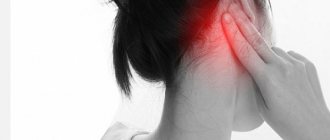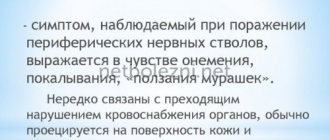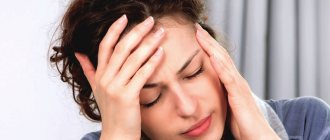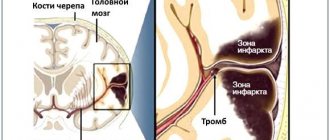Glaucoma:
Throbbing pain on the right side of the head can begin in those who have a disease such as glaucoma. In this case, a person feels an increase in intraocular pressure, during which the eyes hurt, the eyelids turn red, nausea, weakness appear, and vision deteriorates. The insidiousness of this disease is that at first it does not manifest itself in any way.
If throbbing pain in the head is present in the back of the head, then it may indicate some kind of infectious disease, or if there are tumors in the brain. But these diseases can be reliably stated when pulsation occurs regularly. If these are isolated cases, they occur in the following conditions:
- when a person drank coffee and abruptly gave it up. Ripple occurs because the vessels cannot quickly return to normal after an overstrained state;
- when smoking;
- during an incorrect position during sleep;
- after experiencing overvoltages of various types.
Such pain goes away when a person quits smoking, gives up coffee and is less nervous about various little things.
Cardiac ischemia
In people with an attack of angina, pain most often occurs not only in the chest, but also in the neck and arm on the left side. Unpleasant symptoms occur after vigorous physical activity, long walking, or climbing stairs. The pain goes away completely after resting or taking a Nitroglycerin tablet.
In rare cases, the vein on the left side of the neck may hurt. This condition is not associated with heart disease. The most common cause of this is phlebectasia - pathological expansion of the jugular vein.
Types of throbbing pain in the head in various diseases
If a person focuses on his sensations in the back of his head, understands how long the pulsation lasts and what its frequency is, he can himself determine the presence of a particular disease.
- If the pulsation begins in the morning and there is a feeling of heaviness in the head and an increased heart rate, this is a sign of pressure changes, often hypertension. In some cases, along with these signs, pain in the temples is observed.
- Regular pulsation in the temples of the head indicates the presence of VSD. Often dizziness and nausea are added to the pulsation.
- A slight throbbing pain in the back of the head and a feeling that the pain is radiating to the ear or jaw is the result of hypothermia or the onset of a cold or infection.
- Pulsation in the back of the head and temporal part, as well as in the temples, and this pain is accompanied by weakness throughout the body, perhaps blood vessels are pinched somewhere or a spasm has occurred.
- Symptoms of cervical migraine are sudden attacks of pulsation, while flashes appear in the eyes.
- With cervical osteochondrosis, a strong pulsation occurs in the back of the head, in addition, it becomes dark in the eyes and noise in the ears appears.
- Pain in the back of the head, which spreads to the right side of the head, in the temple area, indicates a strong jump in intracranial pressure, migraine or vasospasm.
Myofascial pain syndrome
Many people have neck and shoulder pain on the left side due to overstrain of certain muscle groups. An unpleasant symptom occurs in people with osteochondrosis of the cervical spine. Muscle tension is a reflex, that is, it develops due to improper functioning of the intervertebral joints.
Myofascial pain syndrome increases due to:
- hypothermia;
- stress;
- incorrect posture;
- vigorous physical activity;
- prolonged sitting in one position.
Myofascial pain syndromes are characterized by the presence of so-called trigger points on the back. When pressing on them, severe pain occurs. Trigger points can be in an active or hidden (latent) state, which determines the severity of clinical symptoms.
Myofascial syndromes can be psychosomatic in nature or appear against the background of chronic spinal diseases. If they develop, you need to consult a specialist (neurologist, orthopedist, vertebrologist or psychotherapist). The doctor will help determine the cause of pain in the left neck and tell you how to get rid of it.
There is a throbbing pain in the head: when should you see a doctor?
There are situations in which a visit to the doctor is inevitable, and the sooner the better for a person to dull the pain at an early stage. So, you should visit a doctor if:
- The throbbing pain does not go away for several hours.
- Intense pain does not stop for several days and brings significant discomfort
- Pain in the back of the head begins in the early morning.
- If the pressure increases during pulsation, you must definitely call an ambulance to avoid a hypertensive crisis.
Migraine
Some people experience periodic pain on the left side of their head and neck. The appearance of pain is usually preceded by an aura in the form of tactile, visual, taste or auditory hallucinations, blurred vision, problems with speech and concentration. A similar clinical picture is characteristic of migraine.
With occipital neuralgia, osteochondrosis, spondylosis, myofascial muscle syndromes, the neck on the left hurts and radiates to the head. These types of headaches have nothing to do with migraines. In medicine they are usually called vertebrogenic. Migraine should also not be confused with tension-type headache (TTH). The latter occurs due to constant stress or prolonged overstrain of the muscles of the neck and shoulder girdle. TTH is characterized by diffuse bilateral headaches radiating to the neck and back of the head.
Treatment
Before starting treatment, you must visit a neurologist, ophthalmologist and therapist. In some cases, you need to contact an infectious disease specialist. Since all doctors unanimously insist that headaches should not be tolerated under any circumstances, you need to take one of the following medications:
- Citramon;
- Farmadol;
- No-shpa;
- Aspirin.
Even if a strong pulsation is felt, the dosage of the above medications cannot be exceeded, since the body will not receive any benefit. After taking the tablet, you need to lie down in silence, because any physical activity leads to a significant increase in pain.
After the doctor has found out the cause of the throbbing pain in the left side of the head, right or back of the head, the patient, in addition to treatment, needs to carry out the following procedures to normalize the body’s condition:
- Perform a warming massage in order to warm up the blood vessels and improve the condition of osteochondrosis and neuralgia. In addition to massage, manual therapy will help improve your well-being.
- A soft and gentle massage will alleviate the condition of intracranial hypertension.
- Japanese acupressure will improve your well-being for various types of pain.
- Regularly measuring blood pressure and bringing it back to normal in a timely manner will help eliminate throbbing pain.
- Physiotherapy will be appropriate for osteochondrosis, neuralgia, increased intracranial pressure and various vascular changes.
- Doctors prescribe physical therapy for all types of throbbing pain.
- Surgery is inevitable for tumors and other serious diseases.
As you can see, throbbing pain in the head is a symptom of many diseases. Therefore, you must definitely consult with a specialist or call an ambulance, because home methods can only get rid of mild pain.
Cervical spondylosis
The disease is a set of pathological changes in the intervertebral joints that form against the background of osteochondrosis. They cause muscle strain, irritation of the nerves, which causes a person to have pain in the neck on the left side and the back of the head. If 5-7 spinal roots are affected, pain can spread to the upper limb.
In the initial stages, cervical spondylosis may be asymptomatic. As the disease progresses, aching pain appears in the neck and shoulder on the left. Many patients are bothered by headaches, dizziness, sensory and motor disorders in the upper limb.
Pathological changes in the spinal column are not always visible on radiographs . X-ray is not very informative in the initial stages of the disease. Therefore, magnetic resonance imaging (MRI) is used for early diagnosis of pathology.
Typical signs of cervical spondylosis:
- change in the distance between the vertebrae;
- degeneration, protrusion, herniated intervertebral discs;
- calcification of the anterior longitudinal ligament;
- pathological changes in the facet joints;
- the formation of osteophytes - bone growths on the surfaces of the vertebrae.
Can't figure out why your neck hurts on the back left side? Get an MRI of the cervical spine! The study will help identify any changes in the spinal motion segments.
Adviсe
An effective means of preventing headaches will always be the desire for a healthy and active lifestyle. To do this you need:
- give up alcohol and nicotine addiction;
- engage in any sport, do exercises regularly;
- Healthy food;
- maintain a daily routine;
- get enough sleep.
Painful sensations are a signal of a malfunction in the body. And you cannot waste time at such a special moment. Remember! Only a doctor can make an accurate diagnosis and prescribe the correct treatment! Be always healthy!
Causes
Migraine occurs against the background of various external and internal causes (triggers), each of which can cause another attack:
- mental and psycho-emotional stress;
- constant severe stress;
- sleep disturbances, insufficient rest at night;
- chronic fatigue (mental and physical);
- smoking;
- previous head injuries (even many years ago);
- excessive physical activity for a particular person;
- hormonal surges: puberty, menstruation (“menstrual migraine”), pregnancy;
- consumption of foods containing tyramine (chocolate, coffee, citrus fruits, nuts, cheese, smoked meats);
- drinking alcohol, especially low-alcohol drinks;
- sharp fluctuations in atmospheric pressure, changes in air temperature;
- overstrain of the senses: sharp sound, bright light, strong unpleasant odor, etc.;
- staying in a hot or stuffy room, etc.
Each person has his own “dangerous” factors. Most of them can be calculated and, if possible, avoided in the future.
How to treat pain on the left side of the neck
Most often, treatment is needed in the presence of pathologies of the musculoskeletal system in the cervical region. Treatment of pain may include the use of lidocaine and novocaine, injections of which are otherwise called “blockade”. This is necessary when the pain intensifies to unbearable. In other cases, various medications, physiotherapy and medical procedures are prescribed that relieve pain and inflammation and are selected individually.
Medicines
A nagging pain on the left side of the neck requires timely treatment, since otherwise the state of health will only worsen. Most likely, for pathologies of the structures of the musculoskeletal system, you will be prescribed:
- non-steroidal anti-inflammatory drugs, which should reduce pain and stop inflammation;
- muscle relaxants to relieve muscle spasms;
- chondroprotectors that will stop degenerative processes in the joints;
- drugs to normalize blood circulation;
- Antidepressants, which will reduce anxiety and nervousness, will create a favorable basis for treatment.
Sometimes, when shooting pain appears on the left side of the neck, you need to use hormonal medications, as well as warming ointments that are applied to the collar area. If you have pain in the neck, do not delay visiting a specialist, make an appointment with a doctor.
Diagnostics
The cause of pain concentrated in one half of the head can be either a malocclusion or organic brain damage, so a doctor should identify the source of the symptom. Taking medications up to this point should be a one-time use if there is no strength to tolerate the symptom. Diagnosis of the disease is based on collecting an anamnesis and examining the patient.
Electroencephalography
To clarify the situation, approaches such as CT, MRI, ultrasound of the vessels of the neck and brain, and EEG can be used. Sometimes, if the left hemisphere of the head hurts, you need to consult an ENT specialist, ophthalmologist, dentist, neurologist, or psychologist.
Advantages of the Health Energy Clinic
The Health Energy Clinic is a multidisciplinary medical center where every patient has access to:
- screening diagnostic programs aimed at early detection of diseases and pathologies;
- targeted diagnostics using modern equipment and laboratory tests;
- consultations with experienced specialists, including foreign ones;
- modern and effective comprehensive treatment;
- necessary certificates and extracts;
- documents and appointments for spa treatment.
Trigeminal neuralgia is a serious pathology that can seriously disrupt a person’s normal lifestyle. Don't let pain and fear take over your thoughts, get treatment at Health Energy.











